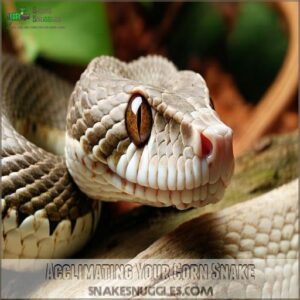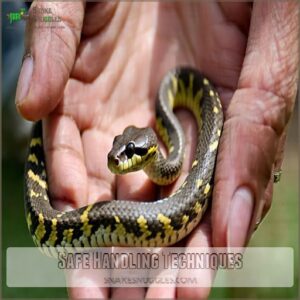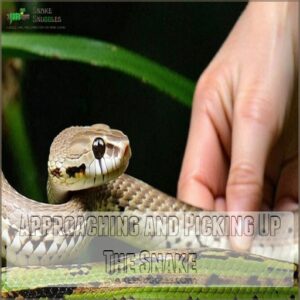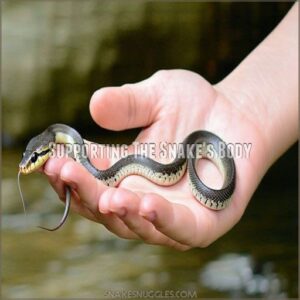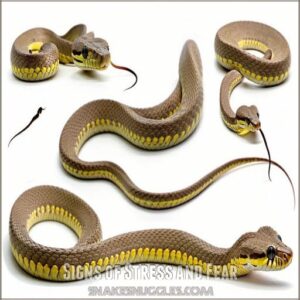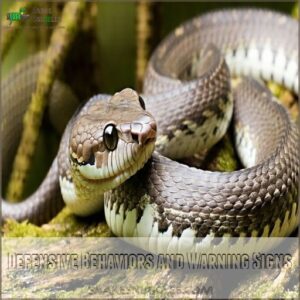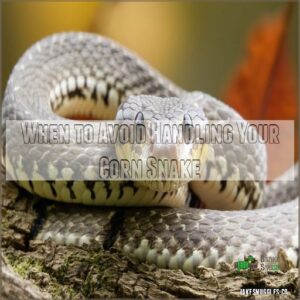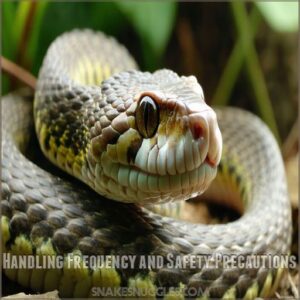This site is supported by our readers. We may earn a commission, at no cost to you, if you purchase through links.
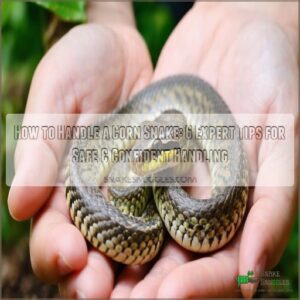
Give your scaly friend 3-5 days to settle into their new home before attempting any handling.
Start with short 5-minute sessions, supporting their body evenly as if you’re holding a delicate chain of pearls. Always wash your hands and approach from the side, never from above.
Watch for tongue flicks (that’s just them saying hello!) and avoid handling for 48 hours after meals.
Once you’ve got the basics down, there’s a whole world of fascinating behaviors and bonding moments to discover. Proper technique is key for handling corn snakes.
Table Of Contents
- Key Takeaways
- Acclimating Your Corn Snake
- How to Handle a Corn Snake
- Recognizing Corn Snake Behavior and Body Language
- When to Avoid Handling Your Corn Snake
- Handling Frequency and Safety Precautions
- Handling Tips and Tricks for Corn Snakes
- Frequently Asked Questions (FAQs)
- How long does it take to handle a corn snake?
- How do you tame a corn snake?
- Should you handle a corn snake after a meal?
- How do you pick up a corn snake?
- Are corn snakes easy to handle?
- Do baby corn snakes like being handled?
- Do corn snakes like being handled?
- How do you bond with a corn snake?
- Do corn snakes like to be touched?
- How to play with your corn snake?
- Conclusion
Key Takeaways
- You’ll need to give your corn snake 3–5 days to adjust to its new home before handling it, and wait at least 48 hours after meals to prevent regurgitation.
- You should start with short, 5-minute handling sessions, supporting the snake’s entire body length while approaching from the side, never from above.
- You’ll want to watch for stress signs like rapid movements, hissing, or defensive postures; if you notice these behaviors, give your snake space and try again later.
- You can handle your corn snake 1–2 times per week, gradually increasing session length as your snake shows comfort through relaxed body language and regular tongue flicking.
Acclimating Your Corn Snake
You’ll need to give your new corn snake friend about 3-5 days to settle into its new home before attempting any handling, just like you’d want time to get comfy in a new place.
Once your snake’s had time to explore its surroundings and eaten a meal or two, you can start with short handling sessions.
These short handling sessions will help build trust between you and your scaly companion.
Initial Acclimation Period
Most new corn snake owners make the mistake of handling their pet too soon. Give your snake at least 2-3 weeks to settle into its new enclosure before attempting any handling. Like moving to a new city, your snake needs time to adjust to unfamiliar surroundings.
- Watch your snake explore every corner of its habitat with curiosity
- Notice how it becomes more relaxed during daily routines
- Feel proud when it starts showing comfortable behaviors
- Celebrate small wins as your snake adjusts to its new home
Importance of Feeding Before Handling
Now that your corn snake’s settling in, let’s talk feeding—it’s your golden ticket to handling success.
You’ll want to see your snake eat one or two meals before starting regular handling sessions. This shows they’re comfortable and their digestive health is on track.
Watch for positive feeding cues like tongue flicking and active movement—these are signs your snake’s ready for some quality bonding time.
Gradually Increasing Handling Time
Once you’ve had successful feeding sessions, it’s time to build trust through gradual handling.
Start with brief 5-minute sessions, watching for stress indicators like rapid movements or hissing, as this gentle approach aligns with the snake’s generally docile and calm demeanor.
As your corn snake’s temperament becomes more relaxed, extend handling time to 10-15 minutes.
Think of it like making a new friend – patience is key.
Positive reinforcement through gentle, consistent interactions will help your snake feel more comfortable with each session.
How to Handle a Corn Snake
You’ll find that corn snakes are surprisingly gentle pets once you learn the right handling techniques, making them perfect for both beginners and experienced snake owners.
Whether you’re picking up your snake for the first time or you’re looking to improve your handling skills, these expert tips will help you build confidence and trust with your scaly friend.
Safe Handling Techniques
After your corn snake settles in, mastering safe handling techniques becomes your next priority.
Start by washing your hands thoroughly – you’d be surprised how many scents can make your snake think you’re a tasty mouse!
Before handling, confirm your corn snake’s habitat setup is suitable, with a temperature gradient, like a warm side around 85°F, as recommended for corn snake for beginners.
Support your snake’s body like you’re holding a delicate piece of jewelry, keeping most of its length supported. This gentle handling approach helps prevent stress and makes your snake feel secure.
Approaching and Picking Up The Snake
Getting up close and personal with your corn snake requires a gentle approach that builds trust. Think of it as making a new friend – you wouldn’t want someone swooping down from above unexpectedly.
Before handling your snake, make certain you have the proper equipment and accessories, such as those found in corn snake handling kits Corn Snake Handling Gear.
Here’s your roadmap for safe handling:
- Wake your snake with gentle taps using a paper towel roll
- Approach from the side, never from above
- Let them catch your scent with tongue flicks
- Slide your hand under their mid-section
Supporting The Snake’s Body
When handling your corn snake, think of your hands as a living branch, providing support across its entire body length.
Keep your movements slow and deliberate while maintaining proper handling posture – it’s like a gentle dance where you’re always supporting at least 75% of their body.
Never grab the tail or head; instead, use your palms and fingers to create a secure, stress-free platform they can naturally explore.
Recognizing Corn Snake Behavior and Body Language
You’ll find that corn snakes are like open books once you know how to read their body language, from their curious tongue flicks to their defensive postures.
Just as you’d notice when your friend’s having a bad day, learning to spot these signals will help you build trust with your scaly companion and know exactly when it’s okay to handle them.
Learning their body language will improve your relationship with your corn snake.
Signs of Stress and Fear
Spotting stress indicators in your corn snake isn’t rocket science once you know what to watch for.
Look out for defensive postures like a retracted head or coiled neck – that’s your snake saying "I need space."
Reduced activity and excessive hiding behavior are classic signs of an overwhelmed snake.
If your typically curious corn snake starts acting withdrawn or displays unusual snake body language, it’s time to back off.
Tongue Flicking and Smelling
Every corn snake’s tongue flick tells a story of scent detection and environmental awareness. Think of their tongue as a built-in GPS system, helping them navigate their world through smell. Their Jacobson’s organ processes these chemical signals, revealing important information about their surroundings.
- Rapid tongue flicking often indicates active exploration and curiosity
- Slow, deliberate flicks suggest focused prey location
- Extended pauses between flicks show comfort and relaxation
- Quick, nervous flicks might mean they’re processing new scents
Defensive Behaviors and Warning Signs
While tongue flicking shows your corn snake is exploring.
Defensive postures signal it’s time to back off. When dealing with stressed or defensive snakes, wearing protective gear like corn snake handling gloves can help prevent bites.
A retracted head and coiled neck mean your snake’s feeling threatened – like a tiny cobra getting ready to say "nope!".
You’ll know your corn snake’s stressed if it starts hissing, shaking its tail like a wannabe rattler, or releases musk (that’s snake-speak for "please leave me alone").
When to Avoid Handling Your Corn Snake
While your corn snake usually enjoys a good handling session, you’ll want to give them space during specific times.
like right after meals or when they’re shedding their skin.
Just like you wouldn’t want someone bugging you while you’re trying to squeeze out of a tight sweater, your scaly friend needs their personal space during these important moments.
After Feeding and Shedding
Your corn snake’s digestive system needs time to work its magic after meals. Wait at least 48 hours post-feeding before handling to prevent regurgitation risk.
During shedding (when their eyes turn cloudy), they’re extra sensitive and should be left alone.
Once they’ve completed their shedding cycle, give them a day to recover before resuming your regular handling frequency. It’s all about respecting their natural processes.
Handling Hatchlings and Juveniles
Baby corn snakes require extra patience during early socialization.
To minimize stress and prevent regurgitation, it’s essential to respect their digestion time after feeding, allowing at least 48 hours before handling safe handling practices.
These tiny explorers are naturally more defensive and prone to biting than adults, so gentle handling is key.
Start with brief 10-15 minute sessions, watching for stress signs like quick movements or hiding behavior.
As they grow through different stages, you’ll notice their temperament becoming calmer and more predictable with consistent, safe corn snake handling practices.
Respecting The Snake’s Mood
Just like us, corn snakes have moods that deserve respect.
If your snake seems cranky or shows stress signs like hissing or tail rattling, skip the handling session.
A respectful approach means never forcing interaction – it’ll only damage your bond and trust. Watch for subtle behavior changes: a retracted head, coiled neck, or lack of tongue flicking are clear signals your snake needs space today.
Handling Frequency and Safety Precautions
You’ll want to handle your corn snake just once or twice a week to help it stay comfortable with human interaction.
While keeping an eye out for signs that you’re overdoing it.
Just like you wouldn’t want someone picking you up every five minutes, your scaly friend needs time to rest between handling sessions, so watch for stress signals like refusing meals or hiding more than usual.
Handling Corn Snakes Regularly
Now that you’ve given your snake time to settle in, let’s talk about regular handling.
Set a consistent schedule of 1-2 weekly sessions with your corn snake, keeping each interaction calm and purposeful.
Think of it like building trust with a shy friend – you wouldn’t rush it. Start with 5-minute sessions, then gradually work up to longer periods as your snake shows comfort and curiosity.
Signs of Stress and Overhandling
While regular handling builds trust.
Watch for stress indicators in your corn snake. Telltale signs include reduced appetite, lethargy, or defensive behavior like tail rattling.
If your snake starts refusing meals or hides more than usual, you’re probably overdoing it. Scale back your handling sessions and let your snake set the pace.
Remember, a stressed snake isn’t a happy snake, so keep those interactions positive and brief.
Bites and How to Prevent Them
Speaking of stress, let’s talk about those rare corn snake bites. They’re usually more startling than painful, but here’s how to prevent them:
- Watch for defensive postures like head retracting or hissing
- Avoid handling when your hands smell like prey
- Support the snake’s body properly to reduce anxiety
- Never grab from above – approach from the side
- Clean your hands before and after with unscented soap
If a bite happens, stay calm and run cold water over the area to encourage release. Think of it like a firm handshake from a nervous friend!
Handling Tips and Tricks for Corn Snakes
You’ll find that corn snakes are like nature’s escape artists, so you’ll want to master these handling tricks to keep your scaly friend comfortable and secure during your bonding time.
Whether you’re a first-time snake parent or looking to polish your technique, these proven tips will help you handle your corn snake with confidence.
while avoiding those rookie mistakes that might make your snake think twice about trusting you.
Gently Guiding The Snake’s Movements
Working with your corn snake is like dancing – you’re the lead, but you’ve got to follow their natural flow too.
Here’s a quick guide to those smooth moves your snake will love:
| Movement Type | What To Do |
|---|---|
| Climbing | Let them wrap gently around your arm |
| Exploring | Guide with open palms as platforms |
| Resting | Support their body weight evenly |
| Active | Move hands alternately beneath them |
| Retreating | Allow gentle withdrawal without pulling |
Remember to stay calm and steady – your snake picks up on your energy and will mirror it right back.
Avoiding Sudden Movements and Restraint
Just as you wouldn’t want someone grabbing you unexpectedly, your corn snake needs patient interaction and gentle handling.
Keep your movements slow and deliberate – no sudden jerks or tight grips.
Think of safe handling techniques as a dance: you’re guiding, not restraining. When practicing corn snake safety, let them explore freely across your hands and arms, maintaining a calm approach that builds trust over time.
Keeping The Snake’s Environment Clean
While maintaining proper hygiene habits is essential for corn snake care, keeping your snake’s environment clean goes beyond regular enclosure cleaning.
Choose the right substrate and spot-clean daily to control odors.
Remember to wash your hands thoroughly before and after handling to prevent spreading bacteria.
It’s a good preventative measure to keep hand sanitizer near the enclosure for quick cleaning between maintenance sessions.
Frequently Asked Questions (FAQs)
How long does it take to handle a corn snake?
Like learning to tango, mastering corn snake handling takes time.
You’ll need 3-5 days for initial acclimation, then start with 5-minute sessions, gradually increasing to 1-2 hours as your snake gets comfortable.
How do you tame a corn snake?
Start with 3-5 days of acclimation before handling your corn snake.
After it’s eaten twice, begin short 5-minute sessions, gradually increasing time.
Support its body gently and handle weekly for best taming results.
Should you handle a corn snake after a meal?
Picture your corn snake peacefully digesting its meal – you wouldn’t want someone jostling you after dinner! Don’t handle your snake for 48 hours after feeding to prevent stress and regurgitation.
How do you pick up a corn snake?
Gently approach from the side and support your snake’s mid-body with one hand.
Let it move freely across your palm while keeping another hand ready to guide its movement.
Never grab the head or tail.
Are corn snakes easy to handle?
With over 90% of corn snake owners reporting easy handling, these docile pets are ideal for beginners.
You’ll find they’re gentle, rarely bite, and become quite comfortable with regular handling sessions lasting 15-20 minutes.
Do baby corn snakes like being handled?
Baby corn snakes need time to adjust before handling.
Start with short 10-15 minute sessions after they’ve eaten twice successfully.
They’ll warm up to you gradually if you’re patient and gentle.
Do corn snakes like being handled?
Like a friendly neighbor, corn snakes can learn to tolerate and even enjoy handling.
They won’t become your best buddy, but with regular, gentle interaction, they’ll stay calm and relaxed during your time together.
How do you bond with a corn snake?
Regular gentle handling sessions build trust with your corn snake.
Start with short 5-minute sessions, allowing exploration while supporting its body.
Keep interactions calm and predictable, gradually increasing duration as your snake shows comfort.
Do corn snakes like to be touched?
While corn snakes don’t feel affection like dogs or cats, they’ll tolerate gentle touching and handling.
With proper technique and patience, they can become comfortable with your touch during weekly handling sessions.
How to play with your corn snake?
Create engaging playtime by letting your corn snake explore different textures and heights.
You can offer climbing branches, paper tubes, or your arms as fun obstacles.
Always supervise and respect their boundaries.
Conclusion
Studies show that 95% of corn snake owners report stronger bonds after mastering proper handling techniques.
By following these guidelines for how to handle a corn snake, you’ll build trust and confidence with your scaly friend.
Remember, consistency and patience are your best tools – start slow, respect their boundaries, and watch their body language.
With time and practice, you’ll develop a rewarding relationship with one of nature’s most fascinating creatures. Soon enough, you’ll both look forward to handling time together.

